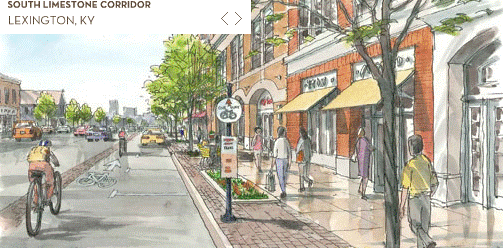Last week, Lexington’s Downtown Development Authority held a “Downtown Improvements Public Forum” to share plans for renovating streetscapes along Limestone, Cheapside, Vine, and Main Streets. (Controversial renovations on South Limestone are already underway.) More ‘open house’ than ‘forum’, the lead agency for DDA’s plans, Kinzelman Kline Gossman, had ringed the room with posters showing artists’ renderings of what the streetscapes would look like and detailing guidelines for street and sidewalk construction. (Large PDF of the DDA streetscape plan here.)
Walking through the door, there was a telling moment. There was an artist’s rendering of what South Limestone would look like after the streetscape project was finished. It was beautiful. Except that it wasn’t South Limestone. The lone rendering of a South Limestone streetscape, while pretty, included non-existent buildings and storefronts.
Throughout my career, I’ve had the opportunity to manage relationships and to interact with numerous creative agencies: design firms, ad agencies, industrial designers, consultants, and the like. I’ve had many opportunities to witness their creative processes at work. I’ve also seen the common pitfalls of such creativity. And Wednesday’s open house struck a familiar chord.
One of the most common pitfalls of creative work is to focus disproportionately on ‘the pretty’. ‘Pretty’ is creative work in its purest, most idealistic form. Pretty designs are often, as their name would imply, beautiful and inspiring. And as long as inspiration is their primary goal, pretty designs can be useful.
But too often, pretty designs are seen as some kind of end point in the creative work. After producing a a creative product, the agency – or, worse, their clients – see the work as complete. They frequently choose not to get ‘dirty’ with the unglamorous implementation of the project. Many design firms see implementation as too mundane, too pedestrian. In their view, they should focus on the pure ‘art’ of their creativity; it is then up to the engineer, the website coder, or the construction foreman to do the arduous task of making the project match the pretty design.
And that is precisely the problem with pretty designs.
When the pretty design meets schedule constraints or cost constraints or other real-world constraints, it can fall apart. When the engineer or construction worker runs up against physical realities, the pretty design often gets severely compromised, and becomes something considerably less pretty.
While pretty creativity gets accolades and awards, it usually only accounts for a small fraction (I’d guess 5 to 10%, based on my experience) of the real creative work on a project. And that real creative work is what I would characterize as ‘gritty’ creativity: the practical, streetwise, action-oriented creativity which actually drives the project forward and finds creative solutions to real-world problems. The success or failure of complex projects depends in great measure on how much ‘gritty’ creativity is employed within those projects.
The disconnect between pretty and gritty is the most common cause of failure in creative projects.
What I saw at the DDA’s forum was an abundance of stylistic and architectural details. They had detailed guidelines for how to design intersections and sidewalks. They had beautiful renderings of what downtown streets could look like after the designs were applied. They had very pretty designs for the future of our downtown.
But what was missing from the forum was any substantial gritty design work for the actual execution of the project.
In the wake of the uncoordinated and under-publicized closure of South Limestone for streetscape improvements, I – and many others in attendance – expected many more practical, gritty details about how the rest of ‘Phase I’ (Cheapside, Vine, and Main Streets) would be implemented. Indeed, I had also hoped to find out more about how future phases would affect my business and those of my neighbors on North Limestone.
The disconnect between ideal (“the pretty”) and implementation (“the gritty”) was troubling: Could we be headed for another South Limestone?
In the South Limestone closure, many businesses seemed to have little time to prepare for losing a big chunk of customers for a year or more. Commuters had little time to adapt to drastically altered traffic patterns. While the city made some public parking available, that parking was a pedestrian-unfriendly 4 to 5 blocks away from some of the affected businesses. In short, South Limestone needed some gritty design for the implementation and coordination of the project.
The pretty planning for downtown streetscapes has been underway for years. But real-world work on Main, Vine, and Cheapside is slated to begin in just 3 to 4 months. This short timeframe creates added urgency for understanding how the rest of the streetscape project will really work. And the utter lack of gritty planning details in last week’s meeting makes answers to the following questions even more important.
- Could all three streets, as with South Limestone, be completely closed?
- Which sections of which streets will be closed? For what periods? What is the planned sequence of closures?
- When can each business on the affected streets expect their businesses to be interrupted?
- How long will such business interruptions last? What will those interruptions look like? Where will they be most severe?
- How can we accelerate the project where business interruptions will be most profound?
- Can we sequence closures around business cycles? Could retailers be least affected during the holiday shopping season? Could work near outdoor cafés be completed by spring?
- How will the city or DDA assist businesses during the closures? How will such assistance be more effective than what was done for South Limestone? Targeted ad campaigns? Special events? Shuttle services from parking garages?
- Will drivers need to find alternate routes (as with South Limestone)?
- What are the likely sources of project delay? How will those be mitigated?
- What, precisely, are the future phases? When are they slated?
To avoid the chaos that accompanied the South Limestone closure, the DDA and the city must begin mapping out the gritty planning of how this project gets executed. And simply throwing such vital details to a construction contractor isn’t acceptable.
The streetscape project is certainly a pretty design. But, if it is to be a successful urban development project – if it is to help us build a better, more vibrant city – then it must get much more gritty as well.



Very well written. Lots of parallels in many fields of design for the real world.
Pingback: The True Cost of South Limestone – CivilMechanics